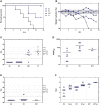Identification of Single Amino Acid Changes in the Rift Valley Fever Virus Polymerase Core Domain Contributing to Virus Attenuation In Vivo
- PMID: 35573791
- PMCID: PMC9096444
- DOI: 10.3389/fcimb.2022.875539
Identification of Single Amino Acid Changes in the Rift Valley Fever Virus Polymerase Core Domain Contributing to Virus Attenuation In Vivo
Abstract
Rift Valley fever (RVF) is an arboviral zoonotic disease affecting many African countries with the potential to spread to other geographical areas. RVF affects sheep, goats, cattle and camels, causing a high rate of abortions and death of newborn lambs. Also, humans can be infected, developing a usually self-limiting disease that can turn into a more severe illness in a low percentage of cases. Although different veterinary vaccines are available in endemic areas in Africa, to date no human vaccine has been licensed. In previous works, we described the selection and characterization of a favipiravir-mutagenized RVFV variant, termed 40Fp8, with potential as a RVF vaccine candidate due to the strong attenuation shown in immunocompromised animal models. Compared to the parental South African 56/74 viral strain, 40Fp8 displayed 7 amino acid substitutions in the L-protein, three of them located in the central region corresponding to the catalytic core of the RNA-dependent RNA polymerase (RdRp). In this work, by means of a reverse genetics system, we have analyzed the effect on virulence of these amino acid changes, alone or combined, both in vitro and in vivo. We found that the simultaneous introduction of two changes (G924S and A1303T) in the heterologous ZH548-RVFV Egyptian strain conferred attenuated phenotypes to the rescued viruses as shown in infected mice without affecting virus immunogenicity. Our results suggest that both changes induce resistance to favipiravir likely associated to some fitness cost that could be the basis for the observed attenuation in vivo. Conversely, the third change, I1050V, appears to be a compensatory mutation increasing viral fitness. Altogether, these results provide relevant information for the safety improvement of novel live attenuated RVFV vaccines.
Keywords: RVFV; attenuation; live vaccines; mutagenic drugs; reverse genetics; viral polymerase.
Copyright © 2022 Borrego, Moreno, López-Valiñas, de la Losa, Weber, Núñez and Brun.
Conflict of interest statement
INIA has filed an international patent application (code # WO2021/245313A1) for 40Fp8-based RVF vaccines. The authors declare that the research was conducted in the absence of any commercial or financial relationships that could be construed as a potential conflict of interest. The handling editor MS declared a past co-authorship with the author BB.
Figures






References
-
- Abdelnabi R., Morais A. T. S., Leyssen P., Imbert I., Beaucourt S., Blanc H., et al. . (2017). Understanding the Mechanism of the Broad-Spectrum Antiviral Activity of Favipiravir (T-705): Key Role of the F1 Motif of the Viral Polymerase. J. Virol. 91 (12), e00487–e00417. doi: 10.1128/JVI.00487-17 - DOI - PMC - PubMed
-
- Andrews S. (2010)FastQC: A Quality Control Tool for High Throughput Sequence Data. (Accessed September 1 2021).
-
- Arias A., Arnold J. J., Sierra M., Smidansky E. D., Domingo E., Cameron C. E. (2008). Determinants of RNA-Dependent RNA Polymerase (in)Fidelity Revealed by Kinetic Analysis of the Polymerase Encoded by a Foot-and-Mouth Disease Virus Mutant With Reduced Sensitivity to Ribavirin. J. Virol. 82 (24), 12346–12355. doi: 10.1128/JVI.01297-08 - DOI - PMC - PubMed
Publication types
MeSH terms
Substances
LinkOut - more resources
Full Text Sources
Research Materials

